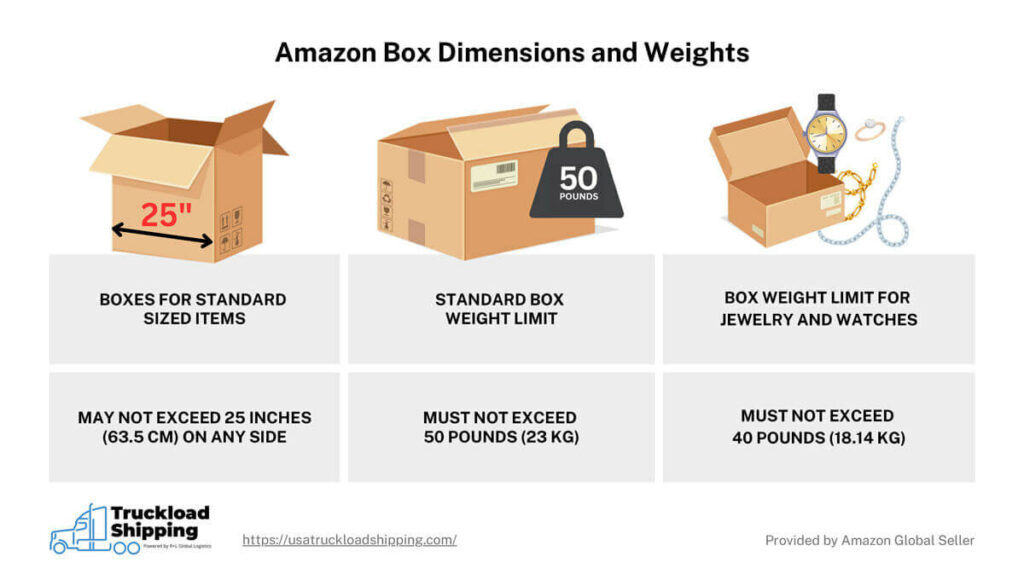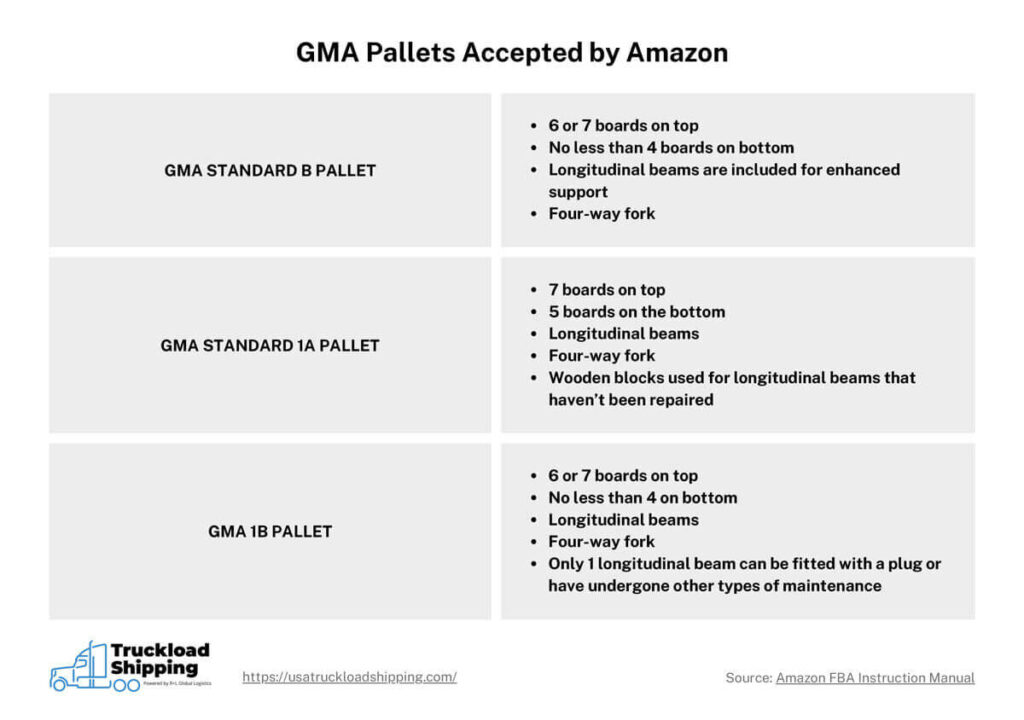When it comes to receiving goods from potential sellers, Amazon’s pallet requirements for inbound shipments can be quite strict. If even one thing is wrong about your shipment, the entirety of your load will be rejected.
Key Takeaways:
We’ll give you the tools you’ll need to follow Amazon’s many pallet requirements to ensure your shipments are successful.
There are certain preparations that must be made before sending a palletized shipment. Amazon requires sellers to provide them with details about the items shippers want to send and how they will be transported.
Before preparing a pallet, businesses should register themselves as a seller with Amazon by making an account. Afterward, shippers will use a shipment creation workflow that allows them to submit important information regarding their palletized load.
The next sections will outline in more detail the needed steps to prepare a pallet of items.
When selecting inventory, it's essential to consider several key factors to ensure products will be accepted and handled efficiently at Amazon's fulfillment centers.
This includes:
Taking these steps will ensure shippers are sending goods that will sell and arrive at a facility undamaged.
Now that items have been selected, businesses must pack their goods into boxes and provide Amazon with information about the load.
Amazon requests sellers provide the following package information:
If multiple boxes are being shipped, or you are unsure of how many boxes will be in the shipment, you can provide a close estimate. Shippers can choose not to disclose the contents of their box or boxes and have Amazon process the load. However, picking this option will require sellers to pay a fee.
Packing your boxes correctly is essential, but you should also make sure they meet Amazon’s size and weight limits. I’ve provided a table that shows these measurements.

Boxes may exceed the standard 25-inch size and 50 pound weight if they’re holding oversized goods.
The next step in preparing a pallet for Amazon is to confirm your shipping information. This includes deciding the transport date and the method used for moving the goods.
Amazon sellers have the option of sending small parcel shipments or palletized loads. In the case of palletized cargo, businesses will have to pick between less than truckload (LTL) or full truckload (FTL) shipping.
Amazon pallet size requirements are extremely strict. It’s important to follow these guidelines, otherwise the shipment will be rejected. In the following sections, we’ll discuss Amazon’s height, width, and weight guidelines for pallets.
Under most circumstances, the maximum height that pallets can be is 72 inches (ca. 183 cm). This measurement also includes the height of the pallet and the freight loaded on it.
However, the exception to the 72-inch height limit is when pallets are double stacked. The maximum height limit for double-stacked pallets is 100 inches (ca. 254 cm).
When placing double-stacked pallets into a container, make sure to leave at least six inches between the platform and the top of the container. Having this extra space will make it easier for a forklift to pick up.
Double stacked pallets should leave enough space for workers to unload them as well. The weight of the cargo on these double-stacked platforms also needs to be centered, which will prevent the freight from leaning over and falling.
While accidents can happen, it’s important to have a good driver behind the wheel when transporting pallets. Luckily, R+L Global Logistics has plenty of qualified drivers on its roster.
Amazon requires pallets to be 48 inches by 40 inches (122 centimeters by 102 centimeters). This is the standard size for pallets, which will make them easy for shippers to acquire.
If one piece of freight is too large to fit on a 48” by 40” pallet, then a wider platform can be used.
The weight limit for palletized loads sent to Amazon is 1,500 pounds, or 680.4 kilograms. Amazon doesn’t allow for any flexibility when it comes to this requirement. If your palletized load weighs more than 1,500 pounds, consider using a second platform.
Now that you know the requirements for Amazon pallets, it’s time to start loading packages onto their platform. You should begin by loading heavier freight on the bottom of their pallet and stack the lighter ones on top.
Make sure to load the freight evenly on the platform. This means the freight shouldn’t be loaded on the pallet in a pyramid formation. Freight cannot be hanging over the pallet, either.
Some boxes of freight that are too heavy or large will need to be placed on a single pallet, such as the following:
Make sure that all freight on the pallet corresponds with the shipment ID. Once your pallets are loaded into a trailer, check for 6 in. (15 cm) of clearance between the top of the stack and roof. Additionally, there should be at least 3 in. (8 cm) of space between your pallets and the walls of the trailer.
You can use air pillows, non-metal straps, or safety nets to help keep your cargo in place, while also maintaining the necessary space from the wall. Finally, allow for 8 in. (21 cm) of room between your pallets and the door of the trailer. This provides room for a dock leveler.
Besides the length and width requirements of pallets, there are other specifications that pallets need to meet. For instance, Amazon wants sellers to send their goods using GMA pallets.
GMA is the acronym for the Grocery Manufacturers Association. We have included data and information on different GMA platforms that Amazon will accept.

While GMA is not a specific brand, it is a specific standard. Regardless of where businesses obtain their pallets, they must meet GMA standards. Keep in mind, all pallets sent to an Amazon warehouse must be wood. Platforms that are plastic will be rejected.
All pallets sent to Amazon must abide by ISPM-15 pallet requirements. To do this, your platforms should be heat treated or fumigated.
Pallets must undergo one of these processes to eliminate parasitic organisms that may be living within the wood. These small creatures can threaten the well-being of the environment.
Fortunately, you won’t have to heat treat or fumigate pallets yourself. Most pallet companies ensure their platforms abide by ISPM-15 requirements before selling them to customers. All you need to do is verify the if the pallets you want to purchase adhere to the regulation.
Before wrapping the pallet, make sure the freight stacked on the platform can stand without assistance. Stretch wrap shouldn’t compensate for a poor loading job.
After making this quick check, sellers will need to use clear plastic stretch wrap to secure it.
Use these steps to wrap a palletized shipment:
Securing freight with stretch wrap to a pallet will help prevent it from falling over while being transported. It will also prevent injury to workers when they unload the cargo.
You will need a unique FBA box ID label for each box on your pallet and an additional four pallet labels. First, we’re going to discuss the individual FBA box ID labels.
FBA box ID labels should be placed on the side of the box that’s facing outward once stacked on the pallet. This ensures the labels will be visible when Amazon workers unpack it.
You can also attach other labels to each individual package, such as:
Once your boxes are stacked and secured with wrapping, you’ll place the four FBA Pallet ID labels on the top center of each side of the pallet. Shippers should create a PDF of their label to print as many copies as they require.
After printing labels, shippers will have to confirm with Amazon who their carrier is and provide information about their pallet(s). Business can choose between an Amazon-partnered carrier or a non-partnered carrier.
Whether shippers pick an Amazon-partnered or non-partnered carrier, they will have to pick a date for their pallets to be retrieved.
After selecting the pickup date, review the pallet estimates and their configurations. After confirming, shippers can then review transportation cost estimates for their palletized shipment.
USA Truckload Shipping has the ability to ship freight of all shapes and sizes, palletized or non-palletized, anywhere in the country. If you need to ship a pallet to an Amazon warehouse, secure full truckload or LTL shipping with us, and we can get your freight where it needs to go.
Our article on dedicated shipping lanes can teach you more about how important these lanes are.
Navigating the complex pallet requirements set by Amazon can be extremely difficult. That's where USA Truckload shines. Our team has plenty of experience moving palletized loads of freight to various retailers. We can guide you through these regulations and ensure every shipment you send to Amazon is a success.
Services you can take advantage of include:
Palletize your Amazon load correctly with USA Truckload by your side. Call our team at (866) 353-7178 or fill out your RFP if you’re looking for a strategic partnership.
R+L Global Logistics
315 NE 14th St., Ocala, FL 34470
we have pallet size of 51" x 43.5" x 5.5" inches
is this acceptable by amazon.
pleaser reply with your best knowledge